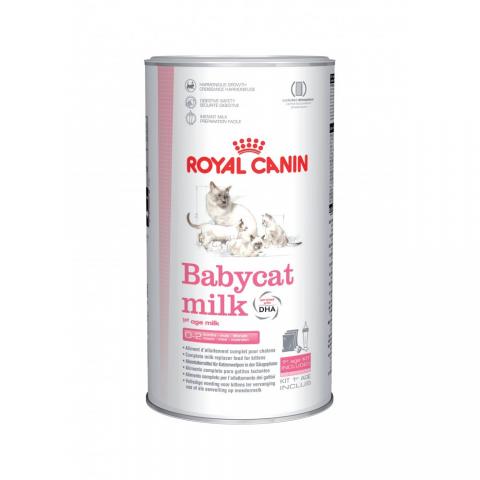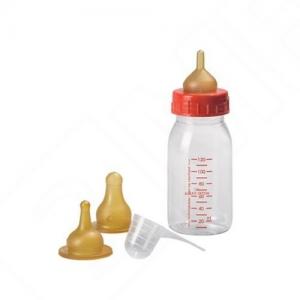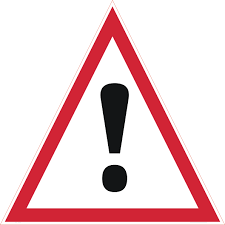Bottle feeding kittens is a challenging and risky process. Find out when to bottle feed, and how to do it as safely as possible.

Bottle feeding kittens is a challenging and fiddly process. There are two situations where you might be bottle feeding kittens:
-
The kittens' mother is not able to feed them at all
-
The kittens’ mother is not producing enough milk and you need to step in to give supplementary feeds
In both of these situations the approach is the same.
The younger kittens are when you begin bottle feeding them, the more difficult it is to do. Mum's milk is best for kittens: much better than any substitute we can give them, so if it is at all possible, when substituting, allow them to continue getting some milk from their mum.
Here are some of our tips on bottle feeding kittens. Please be aware that there are many different approaches to this, and everyone does things slightly differently. Our approach is not the only approach, these are just the tips we have learned from our own experiences. We are always trying new techniques and approaches. If you think we have missed any useful techniques out, please contact us to let us know!
Should I be bottle feeding kittens...?

There are very real dangers to bottle feeding kittens, which we will discuss below. The smaller the kittens are, the more dangerous it is. If we can at all avoid it, we avoid it, or we try to wait until they are as old as we can. Luckily, in the vast majority of cases mother cats are more than capable of caring for and feeding their kittens. However, sometimes this is not the case and bottle feeding kittens cannot be avoided. If mum is not around, or is unable to nurse the kittens, then you will have to step in or they will die. Equally, if they stop gaining weight, or start to lose weight, then you will need to step in. A weight stall, or weight loss for one day is acceptable, but if it continues then we would step in probably on the second or third day, depending on the circumstances.
Kittens tend to gain 10g a day. This is an average, so if your kittens are gaining an average of 7g a day, leave them be and don’t risk the dangers of bottle feeding them. If your kittens’ weights stall for a day, and then they continue to gain weight, that is totally fine (but we might start to weigh them twice a day instead of once). Even if they stalled for 2 days, we wouldn’t panic but we would start to intervene by the end of the second day, if they still hadn’t gained any weight.
It is worth noting whether the entire litter is not gaining weight, or whether it is just one kitten. If it is the entire litter then mum probably doesn’t have enough milk for them all. If it is just one, then he may be being pushed out of the way by the others, and the solution can be to hold him on the nipple to give him chance to eat every hour or two. Alternatively you can remove the larger kittens to let the smaller ones suckle without being pushed off.
First, we will deal with the scary bit….
Dangers of bottle feeding kittens

-
When you feed a kitten with any substance, from any item (bottle, syringe, etc) there is a very real and serious danger that the kitten might breathe in the liquid rather than swallowing it. If this occurs the kitten will develop something called aspiration pneumonia. This means that the kitten has breathed liquid into its lungs. It is a life threatening condition.
-
If you give the kitten the wrong type of milk, you can cause more problems than you solve. Never give a kitten:
- cow’s milk: kittens are lactose intolerant and it will likely give them diarrhea which can cause life threatening dehydration very quickly,
- those little bottles of ‘kitten milk’ you can buy in supermarkets: these are sugary treats and do not contain the nutrients that a kitten needs to grow
- Some people use goats milk, or their own home made mix - we haven’t tried either of these options, but be aware that there are mixed opinions about these.
- We use Royal Canin Babycat Kitten Milk Replacer (KMR) (#affiliatelink). Be aware that the instructions suggest mixing the powder with an equal quantity of water. We have found this ratio to be far too concentrated for small kittens, and we generally mix at least 2-3 parts water to 1 part milk powder (we make it up to roughly the consistency of water)
-
Never feed the milk when it is hot, or cold. As with a human baby, the milk should be body temperature for the kittens. Put a drop of it on your arm to test that it is the right temperature: if it feels hot or cold, it is not right.
-
Never microwave kitten milk replacer (KMR). Microwaving it destroys the proteins in the milk. If you need to heat it again, place it in a bottle or container and then put that into a bowl of warm water to heat it gently.
-
Never give kittens out of date KMR - it goes out of date very quickly and then the nutrient content deteriorates, and it can even make kittens poorly if it is rancid.
-
Never give kittens KMR that is from a packet that has been open for a while - it gets rancid very quickly.
-
Never mix up a big batch and then feed the kittens from it for days. We mix fresh milk for every feed, even if the next feed is only 2 hours later. That way we know it is fresh, and we don't need to worry about heating it up. If you would like to, you can mix a day's worth of milk, keep it cool and covered, and warm up as much as you need in the way described above.
Tips for bottle feeding kittens
-
Never feed a kitten that is not swallowing. If a kitten is not swallowing, you need to take him to a vet as he may have serious health problems like a cleft palate. If he cannot swallow, there is a huge risk that he will breathe in the milk.
-
Whenever you feed a kitten, you must always have them in the correct position. NEVER feed them like a human baby, on their backs. ALWAYS position them with their paws on the work surface. Put one of your hands very gently around their head, tilting their head slightly upwards by about 45 degrees - this is the position they would feed from their mother in. Put one finger from your hand around their head/neck gently on their neck and use it to make sure that they are swallowing. If they are swallowing, you will feel the tiny little movements in their throat with your finger.
-
Don’t use a bottle! This might seem a little crazy, but we have found it very challenging to get kittens to suckle from a bottle nipple. Our preferred method is to use a syringe, or a pipette is even better. We use these pipettes from Amazon. There are benefits and drawbacks to each of these. A pipette allows you to have a lot of control over the release speed of the milk. If you use a syringe, make sure it is a very sensitive one. We always place the pipette/syringe into the side of the kitten’s mouth - that way, if a bit of milk squirts out, it will tend to squirt straight out of the other side of the mouth, instead of down the kitten’s throat which would risk aspiration pneumonia.
-
The drawbacks of pipettes and syringes is that sometimes a lot of the milk spills on the floor. this makes it difficult to know how much the kitten has had.
-
If you do use a bottle, never cut a hole in the teet/nipple. Cut a cross instead. If you cut a hole the liquid will constantly flow into the kittens mouth, and could cause aspiration pneumonia. A cross will only release the liquid when the kitten suckles.
-
If you have never fed a kitten before, ask someone who has to show you how to do it. There may be a local vet or cat rescue that could demonstrate it to you.
-
Do not overfeed a kitten - this can be dangerous. Find guidelines for kittens of the age/weight that your kitten is. If in doubt, err on the side of caution: it is better to slightly underfeed a kitten than to overfeed. As long as they are getting a reasonable amount of nutrition they will be ok - but if you overfeed them and they get sick, then that is more serious.
-
Remember, if the kittens do not have their mother with them, then after every feed, you will need to stimulate the kitten to go to the toilet, as their mother would for them.
-
If kittens are very small, remember that you need to keep them warm. Cold kittens will not suckle. Equally, do not make them too hot either! If your kittens have gotten too cold, you must warm them up before you feed them. Kittens' systems are not capable of digesting food when they are cold, so it is dangerous to feed cold kittens.
-
If you have newborn kittens that cannot feed from mum, give them some Kittystim colostrum - available on Amazon here. Colostrum is a critical element of mum's milk in the first 24-48 hours. It contains immune boosting elements that pass through the kittens' gut wall to set up their immune system. So it is a serious disadvantage if the kittens miss out on it.
Conclusions
Bottle feeding kittens is a risky and dangerous business. We avoid it where we can, but raising kittens is a constant act of balancing risks and benefits: sometimes bottle feeding is the best way, and sometimes it is the only way. Don't jump to it too quickly. If you need to do it, try and find someone to show you how to do it, and if you can't do that, read as much as you can, and then commence very, very slowly. Take your time. Don't get frustrated - be patient. It is a time consuming and stressful thing to do, but keep your cool! Hand rearing kittens is very rewarding, once you get over the initial fear.
Also, don't beat yourself up if you don't save a kitten. The truth is that survival rates are quite low for newborn kittens who are struggling. Without their mum, it is hard for them to thrive. And if they have their mum but are failing to thrive anyway, the chances are that they are not robust enough to live. All that being said, we do everything we can, because on the occasion when you do manage to save a kitten, it makes all of the efforts totally worth it. So do everything you can to save them, but be psychologically prepared to lose them.
Read more...
- blood groups and neonatal isoerythrolysis
- silver shaded British Shorthairs
- how many kittens will my cat have?
Expert breeders of British Shorthair kittens. All of our articles and product reviews are the result of years of research and experience. Bottle feeding kittens is something that we avoid where possible, and use pipettes instead. Find out if we have any British Shorthair kittens available...